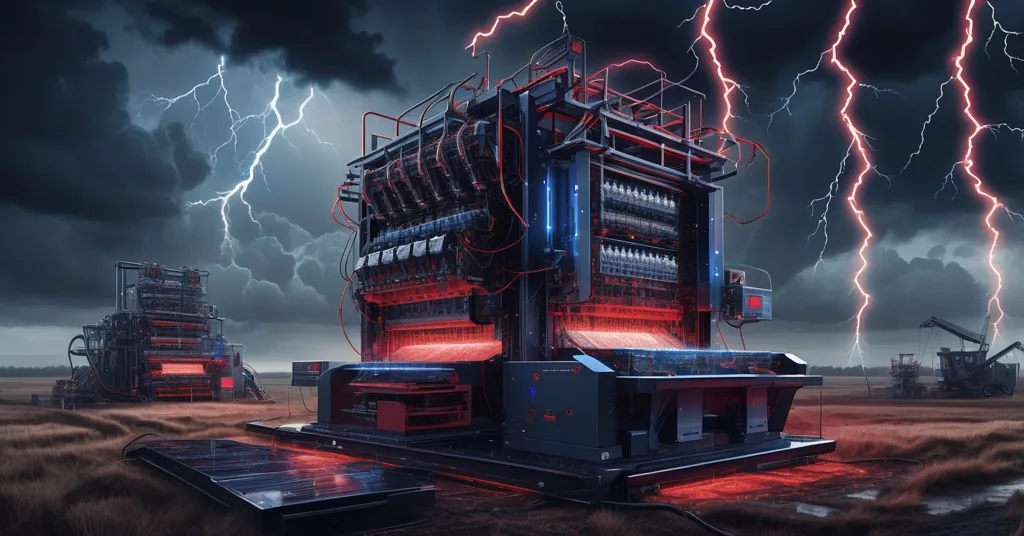ASML’s Role in Bitcoin Mining Under Threat from U.S.-China Geopolitical Tensions

ASML: The Hidden Backbone of Bitcoin Mining and AI Caught in a Geopolitical Firestorm
A Dutch powerhouse named ASML, tucked away in the quiet town of Veldhoven, Netherlands, is the unsung hero behind the tech that powers Bitcoin mining rigs, AI breakthroughs, and the digital world as we know it. Valued at $300 billion, this company builds the most intricate machines ever crafted by humans—lithography systems that create the advanced chips driving our decentralized future. But ASML is now ensnared in a brutal geopolitical clash, with U.S.-China tensions, export bans, and political chaos threatening the supply chains that keep Bitcoin’s network humming and blockchain innovation alive.
- ASML’s Vital Role: Crafts cutting-edge lithography systems for semiconductors powering AI and Bitcoin mining hardware.
- Political Battleground: U.S. export curbs to China and tariff threats disrupt ASML’s global reach.
- Crypto at Risk: Supply chain chaos could spike costs and delay next-gen mining gear.
ASML’s Tech: The Engine of Bitcoin Mining and Beyond
Let’s break this down to the basics. ASML creates lithography systems—think of them as high-tech printers that use light to carve tiny circuits onto silicon wafers, the raw material for computer chips. Their extreme ultraviolet (EUV) technology takes this to a mind-boggling level, working at scales so small (nanometers, or billionths of a meter) that it allows chips to pack billions of transistors. These are the chips inside Nvidia GPUs, Microsoft’s cloud servers, and the Application-Specific Integrated Circuits (ASICs) that Bitcoin miners use to crunch through trillions of hash calculations per second (a measure of how many guesses a miner makes to solve Bitcoin’s block puzzles). Without ASML’s machines, which can cost up to $400 million each and stretch as long as train cars, the hardware securing your BTC or running Ethereum nodes wouldn’t exist in its current, powerful form.
As Chris Miller, a Tufts University professor and author of Chip War, puts it:
“It’s the most complex machine humans have ever created, drawing on a supply chain that stretches across Europe, the United States and Asia, and harnesses fields like material science, physics, manufacturing, design and optics.”
In 2023, ASML pulled in a staggering $32.3 billion in revenue, with forecasts to hit $65 billion by the end of the decade, driven by skyrocketing demand for AI chips. But here’s the catch: this complexity makes ASML a fragile linchpin. Its global supply chain is like a house of cards—one wrong move, and the whole structure could tumble, impacting everything from AI startups to Bitcoin miners hunting for the latest, most efficient rigs, as discussed in various Reddit threads on ASML’s impact.
Geopolitical Tensions: A Direct Hit to Global Supply Chains
ASML isn’t just a tech company; it’s a geopolitical lightning rod. Since 2019, the U.S. has banned ASML from selling its top-tier EUV systems to China, citing national security fears over advanced tech reaching Beijing. The Biden administration tightened the screws further, slashing ASML’s sales to China from nearly 50% of its revenue last year to a projected 25% now, with recent updates on these export restrictions highlighting the ongoing tension. Meanwhile, recent U.S. tariff threats on European imports—briefly floated at 50% before being walked back—sent shockwaves through markets, tanking ASML’s stock and rattling investor nerves. Closer to home, the collapse of the Dutch government amid trade talks with China has frozen negotiations, piling on more uncertainty.
ASML’s CEO, Christophe Fouquet, doesn’t hold back on the fallout of these international power plays:
“The people you try to stop will work harder to be successful.”
He’s pointing at China’s dogged push to build its own tech. Companies like Huawei are grinding away at domestic lithography systems, even hiring former ASML engineers. Sure, they’re light-years behind on EUV, but they’re gaining ground on older tech, as explored in expert discussions on geopolitical semiconductor battles. Fouquet also slams the economic stupidity of tariffs:
“If you want to manufacture chips in your home country, you have to make sure that the cost of those chips is reasonable. If you have tariffs, of course the cost goes up.”
Nvidia’s CEO, Jensen Huang, piles on with his own warning about U.S. policy backfiring:
“Shielding Chinese chipmakers from U.S. competition only strengthens them abroad and weakens America’s position.”
Fouquet admits ASML’s hands are tied on much of this mess:
“A large part of it is still out of our hands. It doesn’t matter how many obstacles you put in the way.”
But he’s crystal clear on the stakes:
“We cannot be naïve. This industry has become strategic for everyone.”
Impact on Bitcoin Mining and Crypto Hardware
So, why should Bitcoiners and crypto enthusiasts care about some Dutch company’s drama? Simple: the hardware that powers Bitcoin mining and blockchain networks—ASICs from manufacturers like Bitmain and MicroBT, or GPUs for altcoin mining—depends on the advanced chips ASML’s machines produce. A next-gen 5nm ASIC, for instance, can boost hash rates by 20% while slashing energy use by 15%, keeping miners competitive. If ASML’s supply chain gets choked by export bans or tariffs, the rollout of such gear could stall, or prices could skyrocket, hitting miners’ bottom lines hard, as detailed in analyses of ASML’s role in the mining hardware supply chain.
China’s role makes this even messier. Despite its domestic mining ban, it remains a manufacturing hub for crypto hardware. If ASML’s restricted sales push Beijing to churn out its own chips—say, via SMIC’s 7nm tech, which lags behind EUV but works for older rigs—we might see a flood of cheaper, less efficient gear. That’s a double-edged sword: more accessible hardware for small-scale miners, but a potential PR disaster for Bitcoin’s already criticized energy footprint. During the COVID-era chip shortages, mining profitability tanked as hardware became scarce—history could repeat itself if ASML’s woes persist, a concern echoed in Q&A forums on geopolitical impacts.
For Bitcoin maximalists like myself, this is a gut punch. BTC is the ultimate store of value, the bedrock of financial freedom, but even I’ll concede that Ethereum’s smart contract platforms and other chains rely on ASML-powered tech for nodes and staking setups. This isn’t just a mining issue; it’s a crypto ecosystem issue. Supply chain snags could slow DeFi platforms or NFT marketplaces that lean on high-performance chips for transaction processing and user interfaces. We’re all in this together, whether we like it or not.
Counterpoints and Future Scenarios: Innovation or Collapse?
Let’s play devil’s advocate for a second. Could U.S. bans on ASML sales to China actually be a net positive, protecting Western tech dominance in the long run? If Beijing’s access to cutting-edge EUV tech is cut off, it might prevent a future where Chinese firms control the crypto hardware market, dictating terms to miners worldwide. National security hawks argue this is worth the short-term pain of higher costs and supply delays. After all, semiconductors are as much a weapon of economic power as they are a tech commodity, a topic covered in depth at ASML’s detailed overview.
But let’s not kid ourselves—this chest-thumping protectionism often backfires. Blocking China doesn’t stop their hustle; it fuels it. Huawei and SMIC might not match ASML today, but give them a decade of desperation, and who knows? Plus, jacking up chip costs with tariffs screws over everyone, from AI innovators to small-time Bitcoin miners already squeezed by energy bills, a point underscored in reports on ASML’s political challenges. And here’s a bitter irony for us decentralization advocates: the very hardware powering our vision of a borderless, trustless future hinges on a single company trapped in old-world power struggles. ASML’s centralized role is a glaring single point of failure for blockchain’s resilience.
As an effective accelerationist, though, I can’t help but spot a silver lining. Disruptions breed innovation. If political barriers choke ASML’s reach, might we see new players emerge—perhaps alternative lithography firms like Nikon or Canon stepping up in older tech, or even wild-card decentralized hardware initiatives in the crypto space? Could Europe’s push for tech sovereignty, fueled by ASML’s lobbying in Brussels and The Hague, diversify the supply chain? Hell, maybe some blockchain genius spins up a fully open-source chip fab model (yes, I know, pipe dream—but let me dream). Fouquet’s own words hint at inevitable progress despite the chaos:
Still, reality bites. ASML’s campus expansion in Veldhoven and financial might (their stock dipped 10% after Biden’s latest curbs but remains a heavyweight) can’t shield them from global trade battles. For Bitcoiners and crypto OGs, this isn’t just about price charts or halving cycles—it’s about the nuts and bolts of our revolution. Ignore this at your peril; it’s as reckless as buying into a shitcoin with a 1000x whitepaper promise. And speaking of scams, don’t fall for any fly-by-night “blockchain chip” ICOs claiming to fix ASML’s mess—real solutions don’t come with hype and a rug pull.
Key Takeaways for the Crypto Community
- How does ASML’s technology fuel Bitcoin mining?
ASML’s lithography systems produce the advanced chips in ASICs and GPUs critical for Bitcoin mining, enhancing speed and efficiency. Any hiccup in their supply chain could delay or inflate the cost of new mining hardware. - What risks do U.S.-China tensions pose to crypto hardware?
Export bans and tariffs on ASML’s machines threaten the global semiconductor flow, potentially stalling next-gen mining rigs and impacting Bitcoin’s hash rate and network security. - Could China’s tech push alter the crypto hardware landscape?
Yes, if Chinese firms like SMIC develop alternative chips, cheaper but less efficient mining gear could hit the market, shifting competitive dynamics and reigniting energy debates around Bitcoin. - Does ASML’s centralized role undermine crypto’s decentralization?
Absolutely—relying on one company for critical tech exposes a weak link in blockchain’s push for resilience, highlighting the urgent need for diversified hardware sources. - Might political chaos spark innovation in crypto tech?
Possibly; geopolitical roadblocks could accelerate alternative manufacturing or decentralized hardware solutions, aligning with the drive for rapid, disruptive tech progress over stagnant protectionism.
ASML’s saga isn’t just a tech story; it’s a glaring reminder of how fragile our digital foundations are when caught in the crosshairs of global power plays. For the crypto community—miners, hodlers, developers, and dreamers—this is a wake-up call to safeguard our vision of freedom, privacy, and financial sovereignty not just in code, but in the physical infrastructure we rely on. Bitcoin remains king in my book, the ultimate bastion against centralized control, but even altcoins and other blockchains carving out their niches deserve hardware stability to thrive. As we push for a world where tech and money answer only to the people, let’s ask ourselves: can we truly claim sovereignty if our rigs hang by a geopolitical thread?



